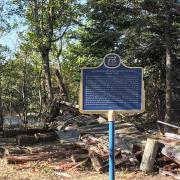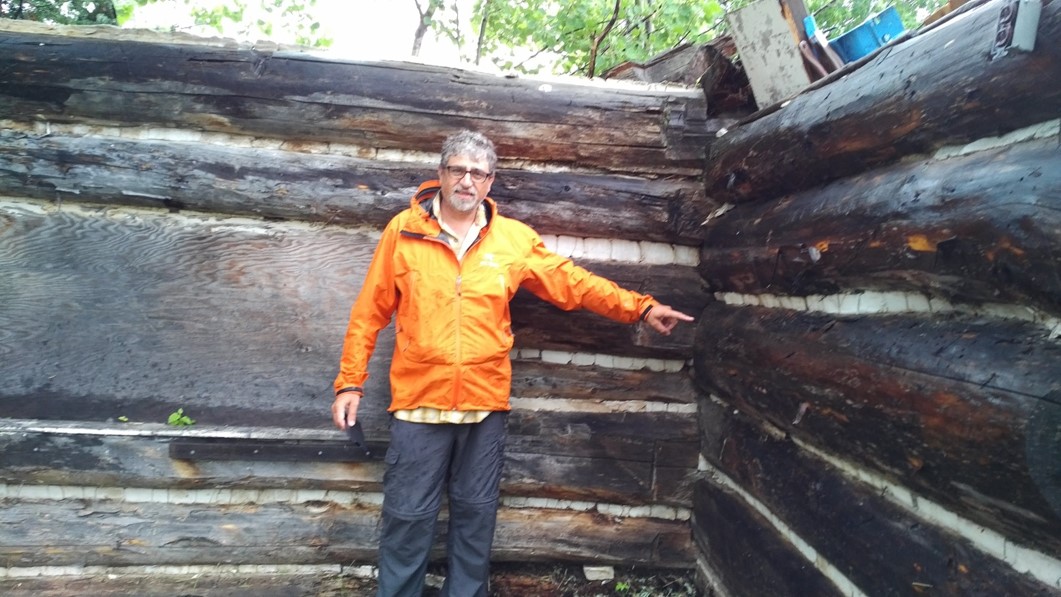 The Mennonite Historical Society of Ontario partnered with the Ontario Heritage Trust to install a commemorative plaque at the site of the Montreal River Alternative Service camp. On September 26, 2024 a plaque unveiling was held at Conrad Grebel University College. View photographs of that occasion on the Trust's flikr site.
The Mennonite Historical Society of Ontario partnered with the Ontario Heritage Trust to install a commemorative plaque at the site of the Montreal River Alternative Service camp. On September 26, 2024 a plaque unveiling was held at Conrad Grebel University College. View photographs of that occasion on the Trust's flikr site.
On September 27-28, 2024, the Society led a trip to Montreal River for the plaque installation.
At left: The plaque at Montreal River on installation day, September 28, 2024. In behind are remnants of the last cabin standing during the Alternative Service camp era, and a scenic view of the mouth of the Montreal River at Lake Superior.

About Montreal River
In 1940, when the German invasion of Great Britain seemed a real possibility, the government of Canada ordered the conscription of men for compulsory service within Canada. Since 1793, Canadian Mennonites had immigrated to Canada on various assurances that their long-standing religious conviction of non-participation in military service would be honoured. In 1940, Mennonite leaders from across Canada went to Ottawa to negotiate a non-military (“alternative”) form of service.
From 1941-1946, the Alternative Service program directed the labour of over 10,000 men in agriculture, road building, fire fighting, hospitals and industrial work across the country.
Over 2,600 of these men were from Ontario; most were Mennonites or Amish between the ages of 21 and 24. For many, this was the first time they left rural farming communities, directly encountered others of differing viewpoints, and thought about their pacifist convictions. Other denominations represented in the camp included Brethren in Christ, Pentecostal, Adventist, Christadelphian, United Church of Canada, and the Society of Friends.
The first Alternative Service camp established in Ontario was at Montreal River, northwest of Sault Ste. Marie. The first conscientious objectors ("COs") arrived in July of 1941. They were literally at the end of the road: the camp was at the end of Highway 17, and it would be their job to extend the road northward. By the spring of 1943, 7 groups of men, a total of over 570 COs, had lived and worked at Montreal River.
In the camp newsletter, the Northern Beacon, CO Paul Storms describes camp life:
The camp's post office is over 80 miles away. The boys seldom leave the camp as there is no place to go....The Conchies appreciate the kindness of the religious director who motors to the Soo about once a week at which time he looks after the purchase of postage stamps, writing paper, camera films, oranges and chocolate bars. These winter months, visitors to the camp are few and far between....Yet the fellows are happy, especially when the mail comes. Most of the boys work in the gravel pits or at clearing the bushlands.
Usually, the workday ended relatively early (especially for those more used to the endless work of the farm), so in addition to letter writing, reading and board games, sports played a big role at camp. The men also improved Montreal River camp by building a chapel and recreation hall.
Religious programming in the camps was provided by the religious directors and visiting pastors sent to the camps by the Conference of Historic Peace Churches. There were a lot of camps to cover, and a diversity of denominations represented in each camp, so this work could be challenging.
Today, the original buildings are gone and the site is a tourist camp. Carved into the only remaining wall of the last log cabin are the names of Alternative Service workers Wilmer Wagler (Shakespeare), Emerson Wagler (Shakespeare), Moses G. Martin and Joe Martin (Wallenstein).


Above: Fred Martin on a 2016 visit to Montreal River, points to the names carved into the log cabin wall. The cabin has since been torn down. Below: Montreal River, 1941. All photos from the Mennonite Archives of Ontario.
